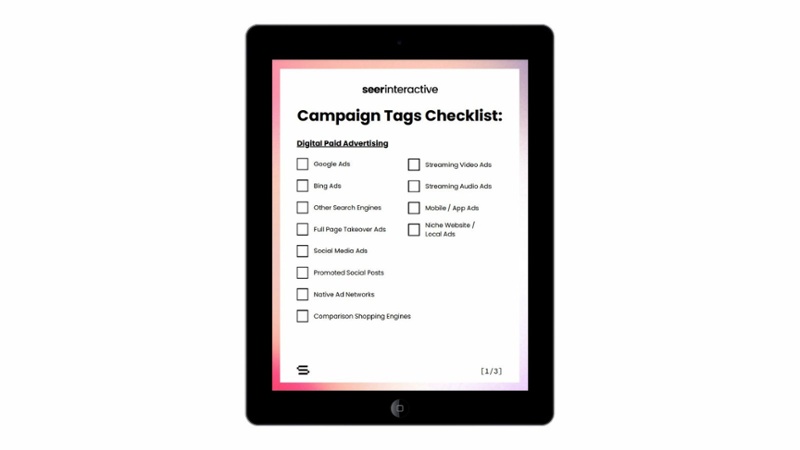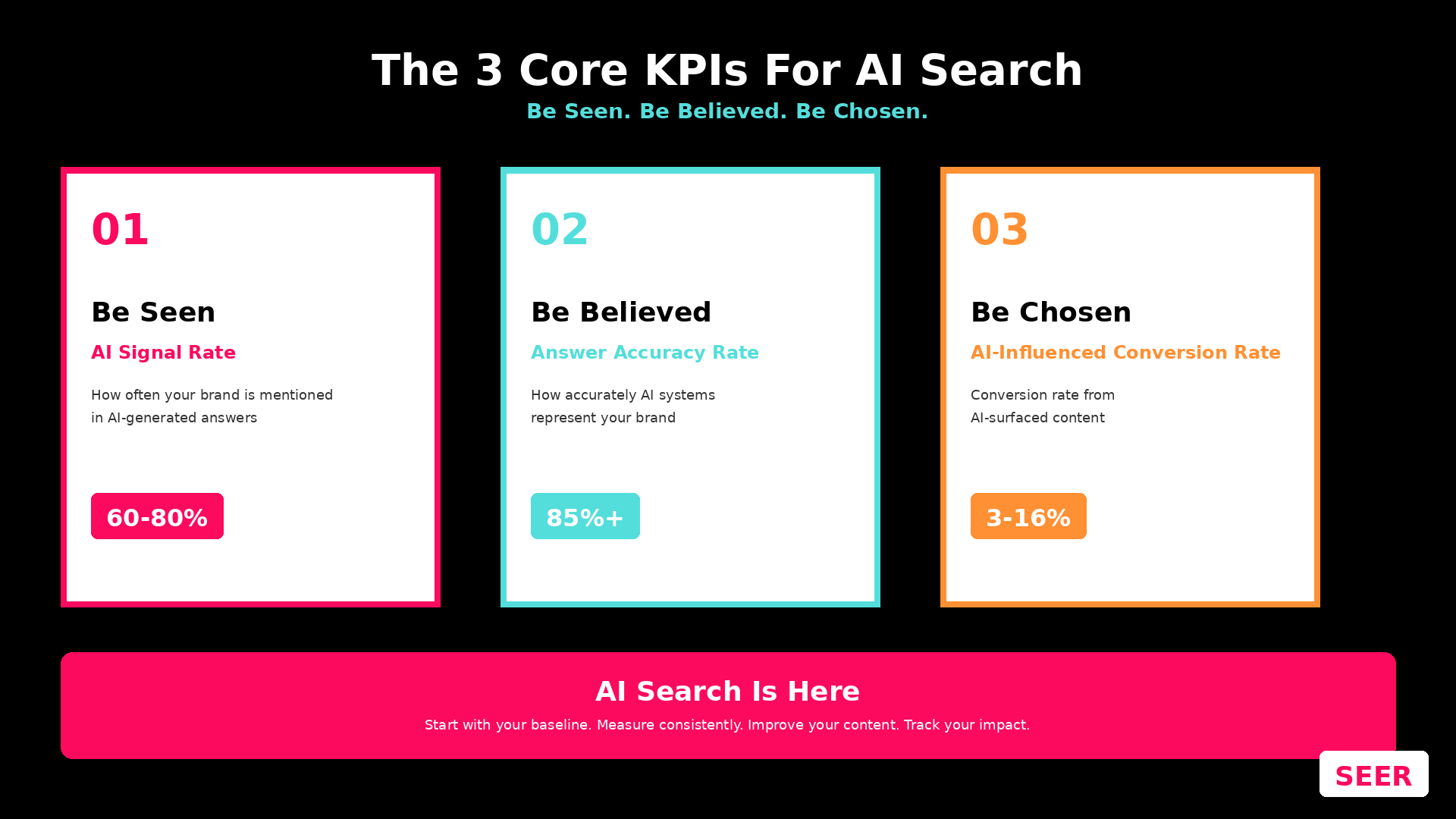Hopefully by now, if you work in marketing, you know that you need to be using campaign tags on all your marketing urls.
They help us reduce dark traffic and provide insight into the value of all those wonderful marketing efforts.
And fortunately, campaign tags are one of the few things that didn't change with Google Analytics 4!
The same parameters work: utm_source, utm_medium, utm_campaign, utm_term, and utm_content.
But even companies who are completely on the campaign tagging train, miss spots to put links. This is a huge miss because the better tagged your links, the more campaign data, the more value you'll get out of GA4's Data-Driven Attribution model.
Maybe you didn’t think to add them because you aren’t responsible for them. Maybe you did think of them but found it was just too hard. Maybe you would tag more links if you just had a simple checklist to make sure you built them all.
Look no further than below for the ultimate guide to Google Analytics campaign tagging.
You can also download it in a checklist format below.
Download Your Interactive Google Analytics Campaign Tagging Checklist:
Now, go find your untagged links and tag ‘em!
Digital Paid Advertisement Campaign Tags
Most of these you probably already tag, paid marketing is the easiest to remember to tag because you’re held accountable for it. The most common deficit seen in digital paid media tagging is granularity, be sure to make full use of the optional utm_content and utm_term parameters. Also note that with GA4, we have another campaign tag, utm_source_platform that allows you to also track the buying platform used.
- Google AdWords
- autotag or manual tag
- Bing Ads
- autotag or manual tag
- Other search engine ads
- Full page takeover ads
- Tag different elements of the takeover if you can, varying the content
- Social media ads
- Examples: Facebook, TikTok, Twitter, Instagram, Pinterest
- Use utm_content to distinguish ad types
- Promoted social media posts
- Make sure to distinguish from natural posts, here’s one method to help
- Examples: Facebook promoted posts, Twitter promoted tweets
- Native Ad networks
- Examples: Taboola, Outbrain
- Display networks
- Examples: Google Display, AdRoll
- Comparison Shopping Engines
- Streaming video ads
- Examples: YouTube, Network TV
- Streaming audio ads
- Examples: Pandora, Spotify
- Consider using a vanity url in the audio, and a different tagged url for clicks on the digital ad
- Mobile/App ads
- Some additional considerations/limitations if you’re linking to app store vs website
- Hyperlocal or niche website advertising
- Other digital advertising
Offline Advertisement Campaign Tags
Any tagging on offline materials requires vanity urls that redirect to pages with campaign tagging, or a scannable link, such as a QR code, leading to a tagged url. The level of granularity you want vs the stickiness of remembering a vanity url is something you’ll need to consider.
There’s a lot of print options out there, so I’m not considering this a comprehensive list, but I hit the highlights. Consider tying a special offer into the vanity url to encourage use of that url instead of your root domain.
- Billboards
- Brochures
- Business cards
- Consider a vanity url for the individual’s name that redirects to their about page
- Print mailings
- Postcards
- Offer letters
- Newsletters
- Other print/direct mail
- Print advertisement
- Magazine spreads
- Newspaper ads (including job listings)
- Placemat ads
- Printed map ads
- Program ads
- Other print advertisements
- Tradeshow handouts
- Other print materials
- Television ads
- Radio ads
- Podcast ads
- QR code
- May be found on many materials, or used to provide the link to any of the above listed in lieu of a vanity url
Natural PR and Marketing Links Campaign Tags
These may or may not be considered part of your paid efforts, but usually are under enough of your control that you can add tags.
- Social media profile links
- Examples: Facebook, LinkedIn, TikTok, Twitter, Yelp
- Natural social media posts (the ones you don’t pay to promote)
- Some social media management tools allow you to set automatic campaign tagging
- Sponsorships
- Examples: Links to events you sponsor or charities you support
- Guest blog posts
- You can’t always rely on the referral, especially if viewers read the blog post through a mobile app so tag the links if you can.
- Social cross-promotion
- Be sure to ask the company you're cross-promoting with how they want their links tagged as well so they can see the value you’re bringing them.
- Local listings
- Yellow Page listings
- Google Business listings
- Other local listings
- Slideshare
- Links within your slides should have campaign tags.
- Job listings
- If possible, update the source based on the job board, listing distribution services will limit the granularity with which you can tag, but use the distribution service as a source instead.
- PDF documents, such as white papers
- Have PDFs that you email or that visitors may land on directly, tag the links to see if those PDFs lead to web visits.
- eBooks
- Whether you’re providing for free or paid, include a tagged link back to your website.
- Affiliate links
- You may want to do some adjustments in Google Tag Manager to use affiliate link tags to set campaign data, rather than adding additional parameters to affiliate links you provide out
- Feeds
- Be careful not to link within your own site, this should be for external feeds, if you have the feed on your own site, adding tags will cause breaks in sessions.
- Press releases
- Add campaign tags to your boilerplate links.
- Add campaign tags to individual links in the press release.
- Other controlled web links
Email Marketing and CRM Campaign Tags
Marketing emails should definitely be tagged, but remember most people at your company probably send email externally too; make sure links in those emails are tagged! Your customer service team may not be in the marketing department, but they have a major impact on your business and website traffic.
Set the team up with templates with bit.ly campaign tags, as well as standards to add campaign tags on the fly to their responses.
- Email auto-responders
- Examples: Responses after filling out a support ticket, order confirmation emails
- Template responses
- Canned responses your team uses as the base to respond to common questions, if they link back to pages on your website, tag those links!
- Customer service general email responses
- Give each customer service team their own tag to add to the end of each link they set in a communication. Use plugins or spreadsheets to help automate this process.
- Email signatures
- Go as simple as one campaign tag for all, or break campaign apart by department, role, or individual.
- Email marketing & newsletters
- Be sure to add granularity as to which link is clicked if there is more than one of the same link.
- Different departments may have regular email newsletters, make sure they are tagged in a way that allows you to both group and separate them easily in your analysis.
- Other emails
Employee Communication Campaign Tags
It can be harder to get them on board, but your employees would probably love to know that their LinkedIn post led to a job applicant or new business.
Help them with suggested campaign tags that will give them credit, using their name for utm_campaign. This also allows you to see how employees are interacting with your site directly.
- Job listings
- When you announce new job listings, add campaign parameters to the link sent to employees to share, and give them the option to customize it.
- Blog posts
- Promoting their own blog posts, provide a tagged link to them when it goes live.
- Internal email communication/announcements
- When providing link references to your website, add tags to track employee visits (but remember they might get shared by employees externally as well.)
- Add campaign tags for intranet links as well (assuming you’re tracking your intranet traffic as well.)
- Intranet links to main website
- Though be careful not to tag internal links of websites tracked together if you track your intranet with your client facing site. You may also be able to rely on natural referral data, but test it!
- Other employee communication links
Don’t forget to take this campaign tagging checklist to-go, download your PDF version here. Thanks to the rest of the Seer team for helping make this list as comprehensive as possible.




